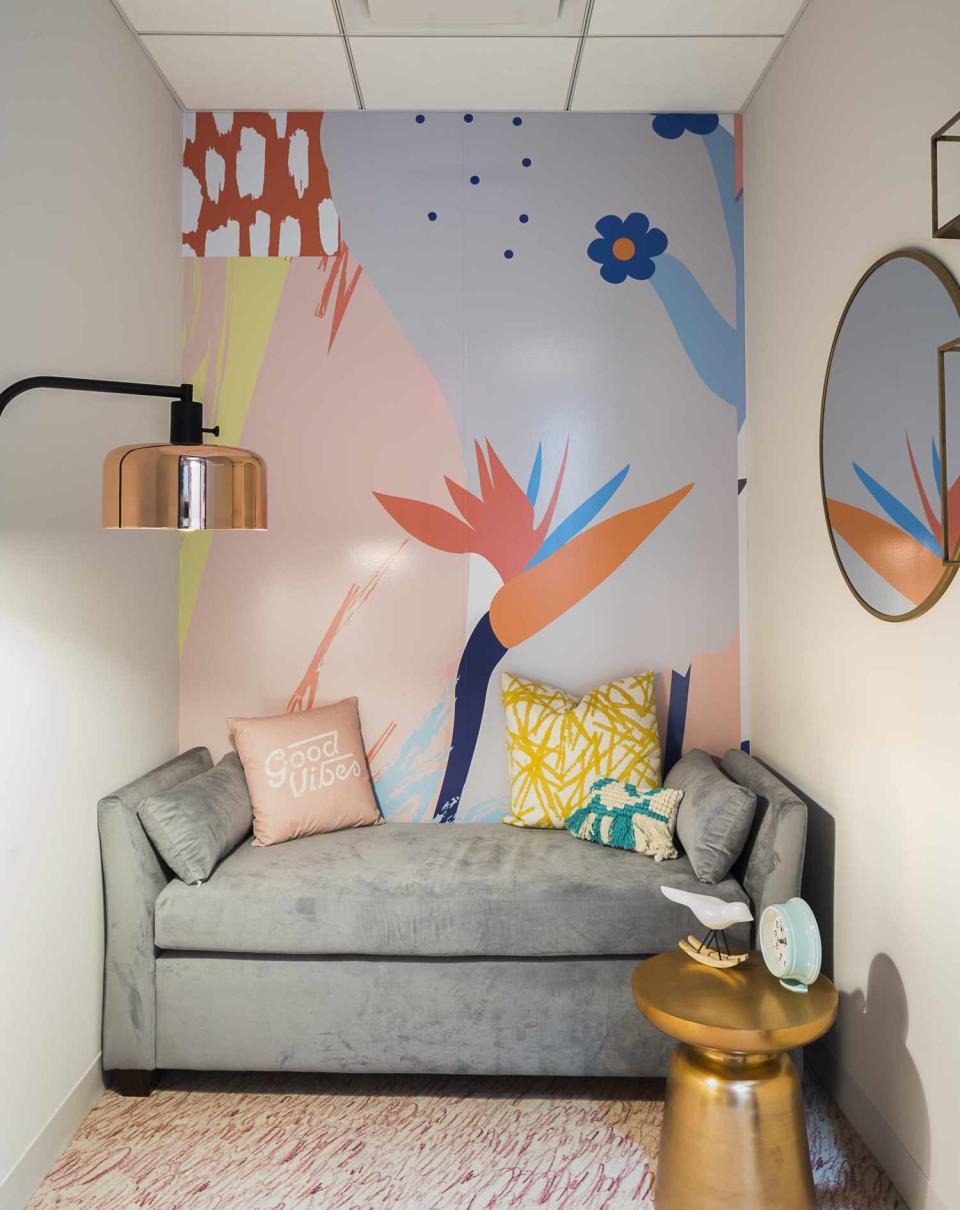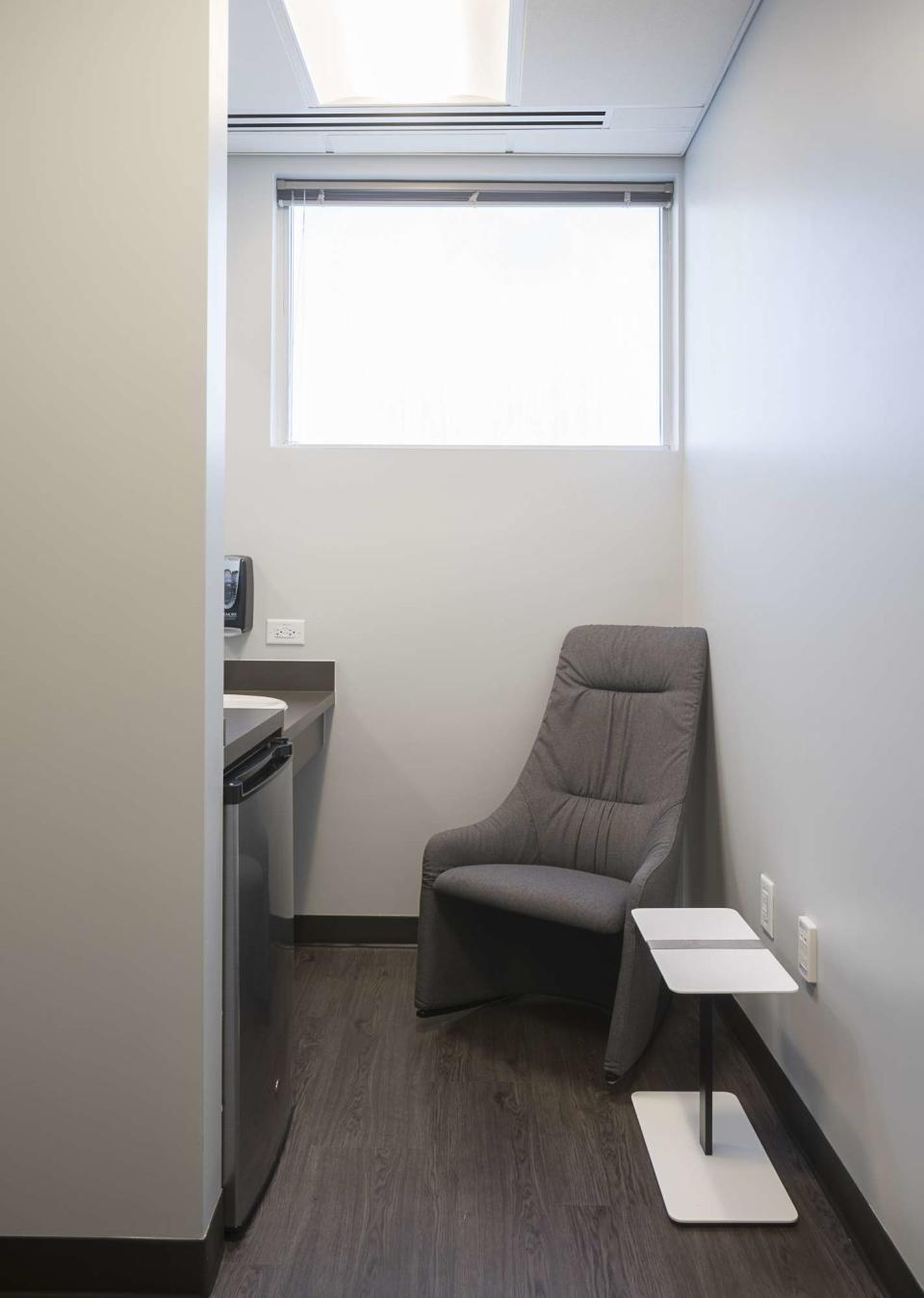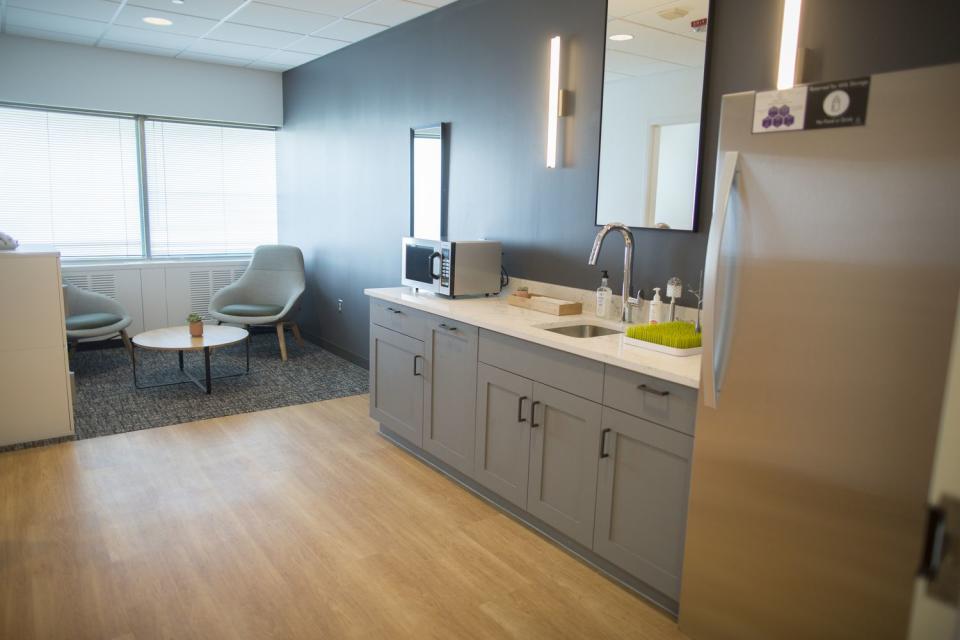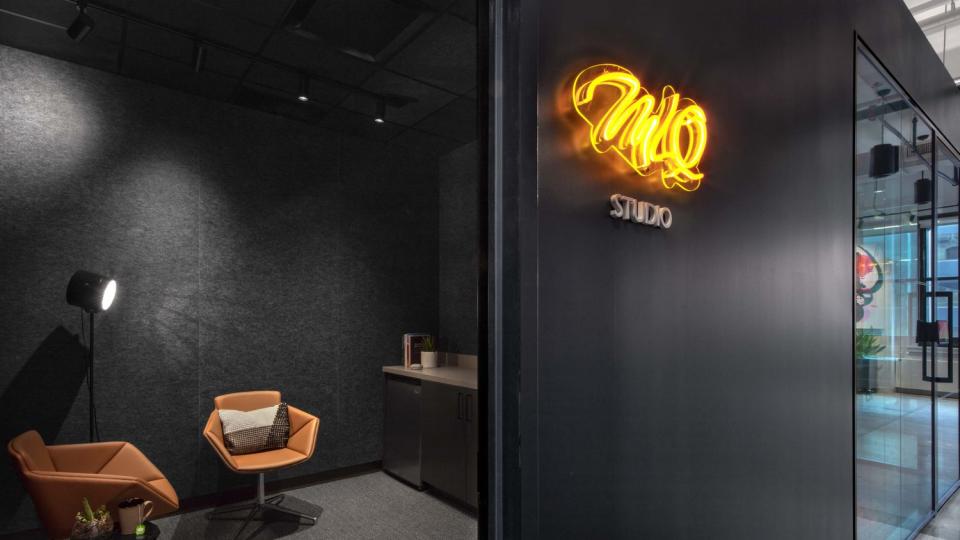This Is What the Ultimate Office Pumping Room Looks Like & Why It Matters
New moms in the U.S. are required to be their own best advocates in the workplace. They have to defend themselves against pregnancy discrimination and fight for paid parental leave all while embarking on the rewarding, but often challenging journey of motherhood. Even before giving birth, many women are anticipating the battles they'll have to face when they head back to work post-maternity leave. A key issue for many employed moms who are breastfeeding their babies: being offered a comfortable, quiet space to pump in the office.
More than 80 percent of mothers start off nursing their newborns, according to the 2018 Centers for Disease Control and Prevention (CDC) Breastfeeding Report Card. And many of them will continue for months—the American Academy of Pediatrics recommends breastfeeding exclusively for the first six months and then continue for at least one year, in order for a child to take advantage of the health benefits associated with nursing.
Yet, in the absence of a federal parental-leave law, most mothers head back to work within 12 weeks of giving birth and the rate of breastfeeding begins to drop. In fact, nearly 1 in 4 new mothers were back at work within just 10 days of giving birth, according to a 2018 report by The American College of Obstetricians and Gynecologists, and the CDC found that less than 50 percent of infants were exclusively breastfed through 3 months and about 25 percent were exclusively breastfed through 6 months. Through those statistics, the CDC determined that "mothers may not be getting the support they need from health care providers, family members, and employers to meet their breastfeeding goals."
That's why there's a strong push for employers to provide new moms with lactation rooms, also referred to as nursing or mother's rooms, where they can comfortably pump two or three times in an eight-hour day. We've all heard—or experienced firsthand—the horror stories of new moms being ushered to pump in broom closets and bathrooms by their employers. But the tide is turning—that is, if movers and shakers in the architecture and design space have anything to say about it.
Lactation Room Rules and Regulations
Thanks to the 2010 Affordable Care Act (ACA), there's an amendment to the Fair Labor Standards Act of 1938 titled "Break Time for Nursing Mothers Provision," which states that companies with 50 or more employees are required to provide "a place, other than a bathroom, that is shielded from view and free from intrusion from coworkers and the public, which may be used by an employee to express breast milk."
But the amendment doesn't specify any particular design requirements or clear provisions for enforcement. "A bathroom, even if private, is not a permissible location under the ACA," says Kathryn H. Anthony, Ph.D., ACSA, distinguished professor at the School of Architecture at the University of Illinois at Urbana-Champaign and author of the book Defined by Design: The Surprising Power of Hidden Gender, Age, and Body Bias in Everyday Products and Places. "So far too many nursing mothers are simply out of luck."
The loopholes have left many new moms pumping in spaces like a "textbook room inside an old cafeteria," as Parents.com reader and school employee Maria Theresa Valdovinos shared.

Maria Theresa Valdovinos Maria Theresa Valdovinos's pumping room at the school where she works.
Dr. Anthony observes, "All too often, the spaces where women are advised to pump are afterthoughts, leftover spaces where no one else wants to be. I've even heard of broom closets or supply rooms, for example. Some women have complained of excessively long walks from their work stations or classrooms to reach their lactation space. This presents a huge problem for schoolteachers who barely have enough time to walk there, pump, and walk back during a short break before they return to class." As if that wasn't enough, Dr. Anthony has found many moms are faced with "lack of privacy, an uncomfortable place to sit, and no easy place to clean up."
What a Lactation Room Should Look Like
Liz York, senior advisor for buildings and facilities for the Centers for Disease Control and Prevention (CDC) in Atlanta, has been standing up for new moms in the workforce for more than a decade. After giving birth to her first child in 2001 and then having twins in 2003, York says she had a supportive employer and pumping policy, but lacking infrastructure led to her "pumping in restrooms, the dressing room of our gym, having to walk outside for 10 minutes to get to an official pumping room, which was very nice but still not adequate."
As a mom and an architect, the experience inspired her to create change. "I vowed that I would do something about this," says York.
Indeed, in 2006, she penned lactation room guidelines for the American Institutes of Architects Best Practice and over the course of the last 13 years, she has updated it several times. The basics covered by the guidelines:
There should be one room per 100 female employees
A 50-square-foot room can meet accessibility guidelines if it accommodates a 5-foot turning radius
Minimum amenities include a tabletop, chair, sink, and refrigerator
The tabletop or working surface should be at least 24 inches deep to accommodate bottles, pumping equipment, and laptops
There should be a supportive and adjustable task chair with casters, as opposed to a "cushy chair," which York says allows a mom to "get work and pumping done"
Essentials include electrical outlets for the pump and laptop, a microwave for sterilizing pump equipment, a deep sink for washing bottles and pump parts, and a refrigerator for milk storage. Undercounter fridges can help to conserve floor space, but they must be situated as to not encroach on knee space beneath work areas.
Why Lactation Room Design Matters
The benefit of providing a lactation room that checks all of the guideline boxes is far greater than many employers might realize. "When it’s done right, what it provides is a moment of respite for these mothers," says York. "These mothers are juggling everything, and this can be a beautiful place for them to step out of all the stressors in their world and just relax because actually, that's what it takes in order to release milk."
A pumping room is supposed to be a cozy, relaxing environment, echos Elfreda Chan, a senior strategist at M. Moser Associates, a global workplace architecture and interior design firm. "Milk doesn’t just come pouring out when the pump is on. There’s a whole process to it and an art to using a pump for the most effective way to extract milk. And when a mother is stressed, less milk is expressed."
RELATED: 12 Easy Fixes for Pumping at Work

Dyer Brown Architecture firm Dyer Brown designed this "tropical oasis" lactation room for a high-tech firm in Boston.
When employers provide a pumping room that promotes relaxation, it leads to longer-term peace of mind for a new mom. She begins to believe that she will be able to simultaneously return to her work life and provide for her child, says York. That employer support helps to build loyalty among employees. Encouraging retention is smart from a financial perspective, as York estimates the cost of building a pumping room to be anywhere from $5-$15K, while estimates show the cost of replacing a mid-level employee is $15K.
"When new working mothers are forced to hide out in restrooms or broom closets to pump milk, they feel like outcasts on the job," says Dr. Anthony. That alone can be enough to drive a new mom to give her two weeks' notice. A well-designed lactation room fosters inclusivity.

Dyer Brown Dyer Brown created this pumping room during a full redesign at Emory University’s Campus Services department in Atlanta, Georgia.
How Companies Are Stepping Up for New Moms
While the move to make pumping rooms more functional for nursing moms seems overdue, major companies are now starting to get on board with this movement. For example, Ford has announced an initiative to bring mothers' rooms to the company. New lactation lounges launched last month at Ford World Headquarters in Dearborn, Michigan. Their amenities include a waiting area featuring seating, a sink with filtered water, lockers, a refrigerator, microwave, and mirror, as well as private nursing suites with comfortable chairs, telephones, Wi-Fi, adjustable lighting, worktables, and industrial-grade breast pumps.

Ford The new lactation lounge at the Ford World Headquarters in Dearborn, Michigan.
A different but equally alluring approach: M. Moser Associates designs and provides its own employees with lactation rooms that are "flexible and multi-purpose, often doubling as a meditation room, prayer room, or a quiet space," according to Charlton Hutton, design director for the firm's New York office. "We look at them as 'wellness' rooms in general."
M. Moser's New York office named the lactation room "MLQ," which stands for mind, lounge, and quiet. "We offer an array of amenities such as soothing face masks, choice of ambient music via Bluetooth speakers, homey lighting, and zero technology, so the user is able to unwind and detach from their work out in the office space," says Hutton.

M. Moser Associates The MLQ room at M. Moser's New York office.
How to Advocate for Lactation Rooms at Your Company
If your company has yet to offer a lactation room, there are ways to get involved to make one possible.
Explain why it's important. York recommends talking to your employer about the benefits of a lactation room. You can say something along the lines of, "Having a quiet space will help me reconnect with my job and be productive." Emphasize that your goals, or the goals of nursing women employed by the company, are in line with theirs.
Team up. There's power in numbers, so you might join forces with other women in your workplace who are planning on getting pregnant or new moms themselves to make a case. "Mobilize together," says York. And if you work for a company that has less than 50 employees, you might work with one or two other small businesses to invest in a shared space—a route York says she has "seen work successfully."
Present the best practice guidelines. Print out the article of AIA best practices and take it to your supervisor, recommends York. Then, point out that this is "something you could do proactively as a company to help show support" for employees who are new moms.
Plan ahead. Given the number of steps and amount of time required for completing a quality lactation room, you'll do well to talk to your employer ASAP—perhaps even before you're pregnant. "The trick is that you need to do it before you need it," says York.
Ultimately, normalization of breastfeeding and guideline-adherent lactation rooms is what will lay the groundwork for new moms to feel supported and be successful as they head back to work. As various companies step it up, experts are hopeful that quality mother's rooms will become more widespread. As York says, "The more we can make 'lactation room' a normal term and say this is a part of life, the better."

